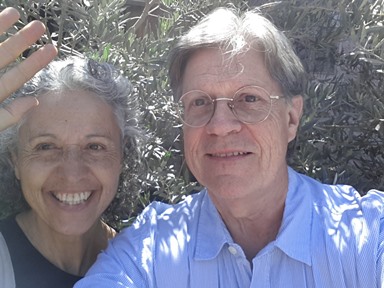Thank you for visiting our site, which has been slowly taking shape since 2003. What started out as a means for promoting our book “The Apocalypse in the Light of the Temple: A New Approach to the Book of Revelation” has now become the platform for a variety of writings, which expand and deepen the new interpretation presented in that book. These writings include a series of academic articles, a commentary, a new translation and a number of essays from the past 35 years of study and reflection on the Book of Revelation. A section on the relevance of the prophecy to the present situation in the Middle East and elsewhere has joined the textual studies. The book is now out-of-print, but can be downloaded free from this site.
At the end of 2019, we uploaded another publication, entitled “Saint John and the Book of Revelation: From Essenes to End-Times”, comprising seven essays on much-discussed themes (Author, Background, Composition, Imagery and Meaning of the Revelation) and in 2021 a full revision of the commentary prior to publication. Two original research articles (“Mt Arbel, the Essenes and the Parables of Enoch” and “New Light on the Origins and History of the Essenes: Implications of the Essene settlement at Mt. Arbel in Galilee”) were added in 2020, accompanied by a gallery of photos taken at the sites on Mt Arbel, for those who cannot visit for themselves. Our present research is focusing on the consistency of the end-time prophecies outlined by the Parables of Enoch, John the Baptist, Jesus Christ and the Book of Revelation, and what this tells us about the foundations of Christianity. When complete, we will upload it here.
We are very grateful to all those who have contributed to this site in one way or another, and especially to the Liturgical Press, San Francisco, for permitting us to reproduce a valuable resource hitherto unavailable on the internet: the essay "Casta Meretrix" by the Catholic theologian Hans Urs von Balthasar. In the future we hope to develop a section with Youtube videos dealing with issues of general interest.
We are a Catholic married couple, not theologians or professors by degree, but simple laymen in matters of Bible exegesis, so some personal background is probably needed. Gloria is a journalist, originally from Mexico City, and I am a GP from the UK, with a Jewish family background (click here for the story ![]() ). Our attention was drawn to the Book of Revelation by a private revelation some thirty years ago. Without going into any details, it is enough to say that this private revelation has given us great love for, and trust in, “the words of the prophecy of this book” (Rev 1,3; 22,7.9-10), as well as a valuable insight into its literal sense. As the starting point of our research, we should tell you about this insight: it is, quite simply, that the two witnesses, or prophets, described in Rev 11,3-13 are real people with a particular mission to perform. With the help of divine grace, the whole interpretation of the Apocalypse “in the Light of the Temple” has grown from this simple insight.
). Our attention was drawn to the Book of Revelation by a private revelation some thirty years ago. Without going into any details, it is enough to say that this private revelation has given us great love for, and trust in, “the words of the prophecy of this book” (Rev 1,3; 22,7.9-10), as well as a valuable insight into its literal sense. As the starting point of our research, we should tell you about this insight: it is, quite simply, that the two witnesses, or prophets, described in Rev 11,3-13 are real people with a particular mission to perform. With the help of divine grace, the whole interpretation of the Apocalypse “in the Light of the Temple” has grown from this simple insight.
You may be wondering why we chose to call the site “new Torah”. As you probably know, ‘Torah’ is a Hebrew word meaning ‘instruction’. In the Jewish tradition, therefore, this is the name given to the divine instruction revealed to Moses and recorded in the first five books of the Bible (Genesis, Exodus, Leviticus, Numbers and Deuteronomy), where it is presented as the basis of the Old Covenant between God and the people of Israel.
In the Christian tradition, the confession of Jesus as the Messiah and the representation of the Christian life as a new exodus leading to the formation of a new Israel by means of a new Covenant, all contributed to the expectation of a ‘new Torah’. Some scholars have argued that this expectation was fulfilled in the person of Jesus, or in the giving of his Spirit, but neither of these proposals agrees with the written character of what came to be known as ‘the Torah’.
According to 'The Apocalypse in the light of the Temple’, however, the Book of Revelation itself can be identified as ‘the new Torah’, and its author, St. John, as ‘the prophet like Moses’ expected by the Jews during the Second Temple Period. As a name for the website, ‘new Torah’ draws attention to these previously neglected and highly significant features of the text of St. John’s Revelation. For further details please read ch. 2 in Pt. II of the book ‘The Apocalypse in the Light of the Temple,’ available on this site.
If you are interested in the contents of the site, and wish make a comment or ask a question, then please contact us by clicking here.
